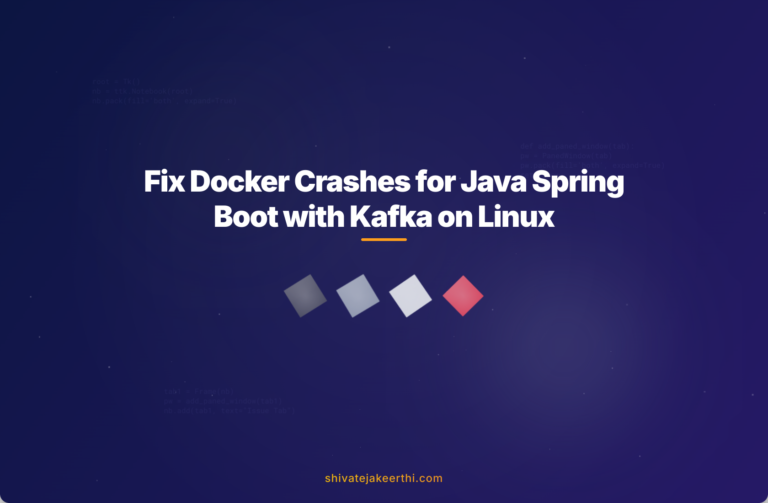Running Docker containers is often straightforward when done locally — but things get tricky when you realize your Docker image runs perfectly on Windows yet mysteriously crashes on Linux. Imagine spending hours crafting your Java Spring Boot application using Kafka and Maven, only to find out it’s suddenly unresponsive in a different environment. This frustrating scenario isn’t uncommon, and developers often spend precious time diagnosing such issues. Here, we’ll explore exactly why a Docker image may fail on Linux but work flawlessly on Windows and discuss practical solutions to get you back on track.
Docker Images for Java Spring Boot Projects with Kafka: Why It Matters
Spring Boot with Apache Kafka is a popular stack widely adopted for creating scalable, robust Java applications. Kafka offers durability, efficiency, and performance-driven reliability, while Spring Boot accelerates Java development with simplified configuration and powerful tooling. Packaging these applications into Docker images is essential for ensuring consistent deployments across various environments, whether development, staging, or production.
If your Docker images aren’t reliable and cross-platform compatible, you’ll face deployment hiccups, unpredictable crashes, and avoidable downtime. Let’s examine this issue together.
Understanding Docker Image Creation
Creating a Docker image usually involves defining your application’s environment through a Dockerfile. It’s critical that your Dockerfile clearly outlines dependencies, environment variables, and build processes. Typically, Java Maven projects are packaged into executable jar files, and Docker uses a base Java Runtime Environment (JRE) or Java Development Kit (JDK) image.
Here’s a basic example of a Dockerfile for a typical Spring Boot application with Kafka:
FROM openjdk:17-jdk
COPY target/myapp.jar /app.jar
ENTRYPOINT ["java","-jar","/app.jar"]
While seemingly simple, subtle configuration differences between operating systems might cause images to behave unexpectedly.
Why Does Docker Behave Differently on Windows and Linux?
Windows and Linux handle file systems, permissions, line endings, and configurations differently. Windows often utilizes Docker Desktop, which internally employs Linux containers through a Hyper-V or WSL2 virtualization layer, masking compatibility issues. Conversely, running on native Linux means any slight discrepancy in configuration or dependencies immediately reveals itself as failures or errors.
Common cross-platform discrepancies causing runtime failures include:
- Filesystem permissions and casing sensitivity issues.
- Mismatch in line encoding (CRLF vs. LF).
- Network restrictions, especially with Kafka brokers and container networks.
- Subtle Docker version incompatibilities.
Analyzing Docker Image Errors: What’s Going Wrong?
When your Spring Boot + Kafka Docker image runs on Windows but fails on Linux, the error logs often look something like this:
Exception in thread "main" org.springframework.context.ApplicationContextException: Failed to start bean 'kafkaListenerContainerFactory'...
Caused by: org.apache.kafka.common.KafkaException: Failed to construct kafka consumer...
Such messages suggest something about Kafka’s networking, dependencies, or incompatible builds within your containers. The problem directly impacts your application’s startup, causing Kafka listeners to fail, disrupting message processing, and preventing the entire application from initializing.
Potential causes include:
- Kafka broker address configured using incorrect hostname or IP addresses.
- Incorrect or missing dependency files at runtime due to filesystem differences.
- Blocked network communication preventing connection between containers.
Troubleshooting Docker Images Across Platforms: Essential Steps
Before diving headfirst into fixing issues, perform these simple yet effective troubleshooting checks:
- Verify Docker Versions: Ensure that you’re using compatible Docker versions on Windows and Linux. Run
docker versionon both environments, and double-check Docker’s official documentation for compatibility concerns. - Confirm Maven Build Stability: The application’s jar file might not be built properly. On both platforms, run:
mvn clean packageThen test the jar locally using:
java -jar target/your-app.jar - Network Configuration & Firewall Rules: Check if closed network policies or firewall rules differ between Windows and Linux platforms. Kafka requires accessible communication channels, so use command-line tools like
pingandcurlinside containers to verify network reachability.
Solutions & Recommendations: Making Your Docker Image Truly Cross-Platform Compatible
Solving docker image compatibility issues involves careful debugging and iterative steps. Here’s how you can debug deeper:
- Inspect Docker container logs meticulously using:
docker logs [container_name_or_id] - Exec into your Docker container to closely inspect filesystem and network reachability:
docker exec -it [container_name_or_id] bash - Use environment variables for dynamic network configurations, particularly Kafka’s bootstrap server addresses, to ensure containers handle different hostnames or IPs correctly on distinct platforms.
When resolving dependency or runtime issues specific to Kafka:
- Check Kafka configurations, such as advertised listeners and bootstrap servers, ensuring they correctly reference brokers accessible from inside your Docker networks. See more on Kafka Docker Configuration.
- Ensure line ending compatibility by configuring Git repositories appropriately (Git’s Line Ending Settings). Remember, Linux uses LF (Line Feed), Windows often uses CRLF (Carriage Return + Line Feed).
- Choose appropriate Linux base images and verify Java compatibility. Using officially supported images like OpenJDK often avoids subtle platform-related issues.
Additionally, follow these best practices when building Docker images for cross-platform consistency:
- Build Docker images consistently on the target system (Linux) or via CI/CD pipelines on standardized Linux infrastructure to reduce cross-environment variability.
- Explicitly specify platform in Docker commands:
docker build --platform linux/amd64 -t your-image . - Avoid overly reliant host-specific configurations or volume mounts that might differ broadly.
- Tag images clearly for proper tracking (e.g., app:1.0-latest-linux).
Build Once, Run Everywhere: Wrapping Up Docker Image Troubleshooting
We’ve discussed an unfortunately common yet solvable scenario—Docker image failing on Linux but working perfectly on Windows for a Spring Boot + Kafka application. In most cases, the root causes revolve around networking confusions, filesystem incompatibilities, and subtle dependency mismatches.
To ensure smooth deployments, invest time upfront intelligently structuring your Docker and Maven build processes, clearly configuring Kafka listeners, and diligently testing containers across environments.
When approached thoughtfully, these headaches become manageable bumps rather than major blockers, ensuring your Dockerized applications remain stable, portable, and reliable—from development environments to production clusters.
Have you encountered similar Docker image compatibility issues? Share your troubleshooting experiences or ask questions below—let’s discuss how to streamline your Java Spring Boot Kafka containers for reliable production use.



0 Comments